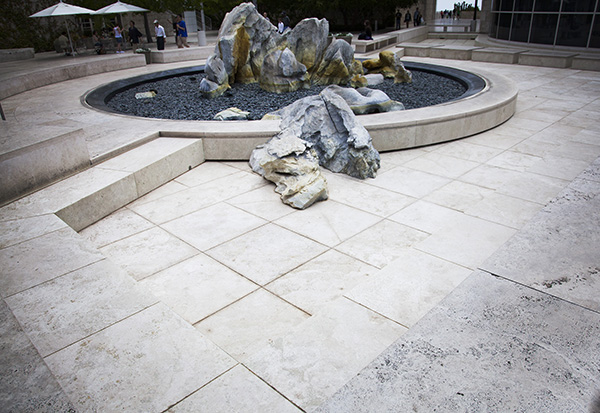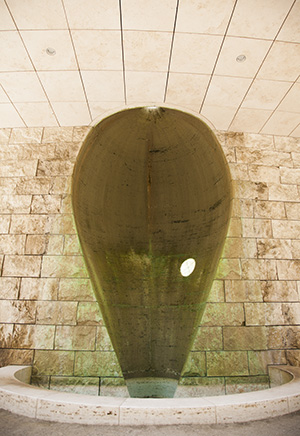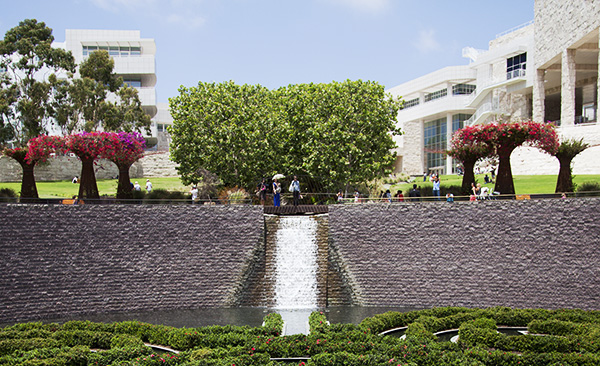Update, October 2016—The California State Water Resources Control Board has modified state water conservation regulations, and as a result we are turning on the fountains once again at the Getty Center and the Getty Villa.
Breathtaking works of art? Check! Stunning architecture? Check! Sunshine? Check! Sweeping vistas? Check! Beautiful gardens? Check!
Gurgling fountains? Well, no.

California is in the midst of its worst drought in recorded history, and recently Governor Jerry Brown asked Californians to conserve water in any way they can. In response, we’ve turned off the water fountains at the Getty Center and the Getty Villa and drained our pools—except those where fish and plants live, and the Central Garden, which is a living sculpture by artist Robert Irwin and a part of the Museum’s art collection.

Our visitors enjoy our water features as much as we do, and many have been disappointed by this change. But many have been pleased to see us taking the drought seriously.
Water conservation isn’t new to the Getty. Thanks to conservation measures large and small, we’ve reduced our overall water consumption by 55 percent since the Getty Center opened in 1997.
Turning off the fountains saves nearly 2,500 gallons a day. It also helps send a message in support of conservation during this long, hot summer—and beyond.
We hope the rainy season comes early and stays late, and we can turn the water back on. But until then, we appreciate your support while we conserve water. We hope there will be plenty of other things to enjoy when you visit the Getty Center and the Getty Villa.

The fountain in the East Garden at the Villa is still gurgling and feeding the plant life.

Robert Irwin’s living sculpture, the Central Garden, will also remain running.




In this time of drought in California, efforts to conserve water are highly commendable. But they must be based on good judgment and a modicum of research.
The Getty Villa recently emptied its beautiful reflecting pond in the outer peristyle (as well as all the other ponds, including the tiny indoor impluvium), ostensibly to conserve the water lost to evaporation. Here is a simple calculation of the water saved:
The pool is 210 feet long, 20 feet wide, and 17 inches deep for an area of 4200 sq ft or 386 sq m, substantially smaller than that of an olympic swimming pool (typically 50 m by 20 m for 1000 sq m). The volume is 5950 cu ft.
Fromm http://www.engineeringtoolbox.com/evaporation-water-surface-d_690.html, the typical summer daytime evaporation rate is 136 kg/hr, the nighttime evaporation rate is 102 kg/hr and the daily evaporation rate is thus 2856 kg/day or 101 cu ft per day (755 gallons per day). This is a tiny quantity of water. According to EPA (http://www.epa.gov/WaterSense/pubs/indoor.html) the average American family of four uses 280 gallons of water INDOORS per day. The evaporation from the Getty pool is thus less than that used indoors by 12 people. A single typical Los Angeles home with a lawn uses more water.
LADWP charges $4.72 per hundred cubic feet of water. The cost of the water lost by evaporation from the Getty pool per day is $4.76. When the pool was emptied, the contents, equal to 59 days worth of evaporation, were dumped. To refill the pool will cost $281. It would be interesting to know what fraction of the Getty Villa’s total daily water use was actually saved, given the extensive gardens, the restrooms, the restaurant, and general maintenance – all of which undoubtedly guzzle water at a rate that dwarfs the pool’s evaporation loss. Meanwhile, tourists visiting this magnificent site are left gawking at concrete holes.
Thanks for your very thoughtful comment. By turning off the ornamental fountains at both the Getty Center and Getty Villa we save nearly 2500 gallons a day — not enough to end the drought, by any means, but a meaningful response. We did not empty fountains that sustained fish or wildlife, so at the Villa, fountains in the East Garden, Herb Garden and near the Museum Store are still operating. As you note, closing restrooms and the dining operations, and eliminating all landscape irrigation and general maintenance would save much more water, but of course would force the closure of both sites entirely. We miss the fountains too, and look forward to the day when we can turn them back on.
It would be neat to see if the getty center could potentially create a greywater reuse system. They could re-use the water to irrigate many of the plants and there are also cool biomimicry options available to clean and even shade the water (preventing evaporation). The bioneers recently had a conference in Marin and used floating islands to clean the water, they are a recycled product made here in california and when plants grow out they will look even prettier. Might be something to look into.
Thanks for sharing such a nice post
I have to agree with the original criticism, especially regarding the trivial amount of water saved v. the amount consumed all over the LA metropolitan area. I just visited the Villa yesterday (Jan 19): magnificent experience but the empty water features left much more than a gaping hole. I hardly need tell the museum that water was a critical part of Roman culture, engineering and architecture. The fact every single element of the Villa has water at its centre is proof of that. While understanding that “everyone has to do their part” in the drought, some things (e.g. the Villa’s water features) merit an exception more than others (e.g. washing a car). The removal of the water was the equivalent of removing exhibits just to make a visible point of solidarity. Not, in my view, a compelling enough justification.
Frank Ruddock, Cambridge, MA
Can some potted drought resistant plants be put in the empty pool bed to still add beauty instead of seeing a empty water less pool, if the drought comes to a end (Praying) then the potted plants can be removed and the water put back on, but there are just (TOO MANY PEOPLE ON TOO SMALL A PLANET) consumng all the water this isn’t just a local problems it’s a WORLD problem and we all really need to conserve, I don’t think we like the taste of OCEAN water on our tongue do we.